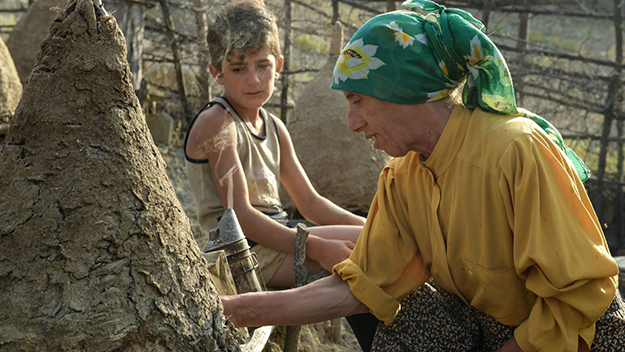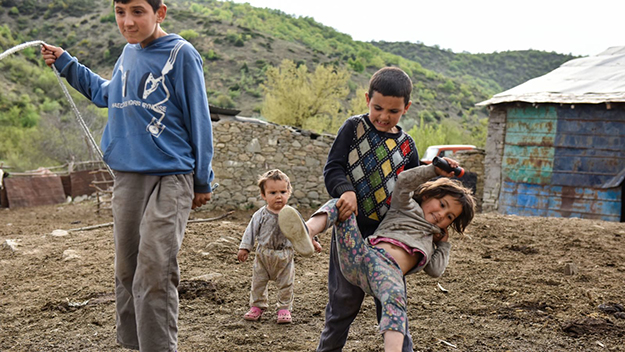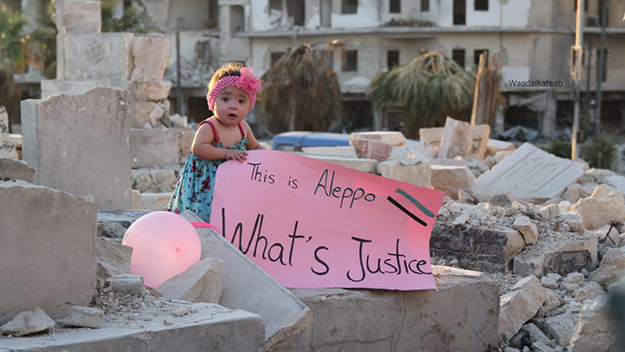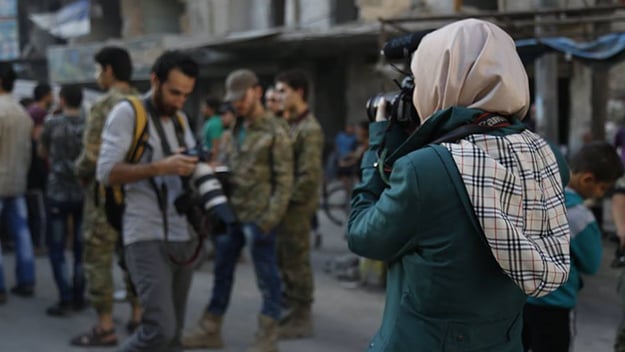Mothers and Daughters: Honeyland and For Sama

Honeyland (Ljubomir Stefanov and Tamara Kotevska, 2019)
A woman walks alone across a valley as bare as the moon. Crouching on a windswept, rocky ledge, she pries loose a stone to reveal a warm, humming, dark gold hive, a city of bees in their perfect chambers. This is the first of many surprises in Honeyland (2019), a documentary set in a rugged, barely inhabited region of Macedonia where an extraordinary woman named Hatidze maintains ancient traditions of wild beekeeping. She herself lives in what amounts to a hole in the rock, a cave-like hut where she tends her ancient mother as gently and patiently as she tends her bees.
At first, as the film wordlessly follows Hatidze on her treks through the desolate countryside and the ruins of a village where bees live among the stones of crumbling walls, we could be watching a movie about survivors in a post-apocalyptic wasteland, or even a story set on another planet, so alien does this life seem. But for all its remoteness—the women live without electricity, running water, or neighbors—many things are universally recognizable in the relationship between the sturdy, middle-aged Hatidze and her bedridden, nearly blind mother: the familial bickering, the caretaking rituals of feeding and washing, the moments of tenderness. The mother, Nazife, is a one-eyed crone with a child’s voice, who occasionally arrests the film with a poetic utterance. “I’ve become like a tree,” she says, explaining why she cannot move from the house. When her daughter asks if she can imagine spring coming, she responds cryptically, “Too many winters have passed.”
Hatidze’s face is a landscape in itself: a nose like a craggy peak, protruding snaggle teeth, beautiful olive eyes, wonderfully alert and expressive, whether grave or amused. It is a shock when she gets on a train, sitting next to a kid with a mohawk, and arrives in the modern city of Skopje to sell her jars of dark red, unfiltered honey. But she is as confident and imperturbable here as in the wilderness, boldly haggling with vendors. She also purchases chestnut hair dye; touchingly, she colors her hair, even though it is always covered by a headscarf.
Honeyland started with a commission from The Nature Conservation Project (NCP) in Macedonia to create an environmental video, and the directors Ljubomir Stefanov and Tamara Kotevska originally focused on the region and then discovered Hatidze and began documenting her beekeeping methods. But during the three-year period in which they filmed, something serendipitous happened. A nomadic family—Hussein and Ljutvie Sam and their seven children—pulled up in a trailer and began living next door to Hatidze. They had a herd of cows and, after observing their neighbor’s success with her honey, decided to keep bees as well—the modern way, in wooden box-like hives. Disregarding Hatidze’s cardinal rule of only taking half of the honey, they sold all of theirs, with the predicted result that their bees attacked hers, causing a total collapse of the local hives. Thus, the film becomes a perfect ecological parable, contrasting a balanced and sustainable relationship with nature and rapacious, short-sighted exploitation.

Honeyland (Ljubomir Stefanov and Tamara Kotevska, 2019)
If this were fiction, it might seem too “on the nose.” As a documentary, it makes its point with an artful dramatic structure and satisfying emotional arc. The filmmakers use contrasting visual styles to emphasize the gulf between two ways of life, with jerky handheld camera intensifying the chaos and messiness of Hussein’s hapless family, the parents always yelling at their unwashed, unruly children. There are upsetting scenes of poor animal husbandry: roughly handling the cows, they get viciously kicked; clumsily approaching their hives, they are stung by incensed bees. In an act that seems to symbolize destructive greed, Hussein and another man cut down a tree with a chainsaw to cart off the bees living in its trunk. Meanwhile, Hatidze’s quiet competence is framed in beautiful, stately compositions, as she ritualistically calls and sings to her bees, brushing them away gently with bare hands before slicing into the oozing honeycomb to remove only her half of the treasure.
Before the falling out over honey, Hatidze befriends the family, playing with the children and taking one boy under her wing, teaching him her ways. (The filmmakers say the Sams welcomed them, and that they are still friendly, despite how badly the parents come off in the film.) With their bees gone and their cows sick, they abruptly pull out in their trailer and are gone. Quiet returns, winter comes; Hatidze chops firewood in the snow, chases wolves off with torches, sits by the little stove singing to her cats. Her mother’s death deepens the silence, snatching all of her human companionship and half of her purpose. But what is left, as the film’s lovely ending affirms, is her resilience and graceful independence.
In Francesco Rosi’s Christ Stopped at Eboli (1979), writer Carlo Levi (Gian Maria Volonté), exiled by Italy’s fascist government to a remote and primitive village in Lucania, comes to admire the character of peasants. He defines a peasant as “anyone who does things, loves what he does, and asks nothing more; anyone who produces.” Hatidze is an ideal of this type; the steady calm of her gaze, the way she stands and moves, conveys a wholeness and solitary contentment almost inconceivably remote from the anxious, self-absorbed, overstimulated culture of modern life. Rosi’s film, made for television in four parts and recently released theatrically for the first time in its complete form, treats its alien, untouched-by-time setting with gentle, rigorous ambivalence. Levi, an outsider, observes the poverty, superstition, and needless suffering; the austere natural beauty; the warmth and earthiness of the villagers. In Honeyland, the filmmakers efface their presence, but the mere existence of the digital footage brings an outside eye to this screenless world.

For Sama (Waad al-Kateab, 2019)
There is no distance between filmmaker and subject in another new documentary, For Sama. Waad al-Kateab is a Syrian journalist who created a series of films for Britain’s Channel 4 called “Inside Aleppo,” documenting the siege and bombing of the city in 2016. In For Sama, she and fellow director Edward Watts weave this harrowing footage together with her own story: her marriage to Hamza, a doctor who winds up running the last remaining hospital in the rebel-held portion of Aleppo, the birth of their daughter Sama, and their determination to stay in the devastated city and continue their fight against the regime of Bashar al-Assad. Her first-person narration, forceful in its simplicity and emotional nakedness, is addressed to Sama as an explanation, apology, and love letter.
The film jumps back and forth between the worst days of 2016, when the city was under ferocious assault by Russian warplanes, and earlier, happier times—Waad and Hamza’s wedding, the couple playing in the snow in the garden of their first home, the announcement of her pregnancy, the jubilation of the first big demonstrations against the regime. Sama appears as an angelic infant, then as the ghostly blur in an ultrasound; as a toddler, then a newborn. This non-chronological time scheme is well-crafted, and perhaps necessary, since the scenes from the hospital during the bombing are so hard to watch. Parceling them out between scenes of ordinary life gives some respite, but ultimately makes the indictment of war even stronger by constantly reminding us of the humanity of the people we see coping with horrific violence. Waad pulls no punches in filming the injured, dying, and dead, the pools of blood on the hospital floors, but nothing comes closer to being unbearable than the sight of two dust-caked young boys weeping over the body of their brother, and the arrival of the mother who insists on carrying her dead son out of the hospital and through the streets herself. (“There is no time to feel,” Waad says at one point of life during the bombardment. But there is plenty of time for the American viewer to feel the deepest shame about our nation’s indifference to Syria and its refugees.)

For Sama (Waad al-Kateab, 2019)
Children are at the heart of the film: we see them swimming in a bomb crater and painting a burned-out shell of a bus. Waad questions them about what is going on, and they display an appalling ability to distinguish between different types of bombs and shells. One boy makes paper cut-outs of all the friends who have fled the city. The fragility of innocent life in the midst of war is most spectacularly illustrated by a centerpiece of the film, an emergency Caesarean performed on a woman after a bombing, a scene with more suspense than any Hollywood thriller.
While the superhumanly stoic Hamza and his team fight to save lives, Waad commits herself to documenting the darkest hours of her city and her movement. (A hysterical woman in the hospital spots her with her camera and screams, “Film this! Why are they doing this to us?”) Much of the footage is captured on a phone or with a handheld digital camera, which she keeps on even when she is running into the cellar during an attack. Images are tossed up out of a whirling, scrambled blur, like flotsam from a shipwreck. When Hamza’s hospital is bombed, killing 53 people, footage from security cameras shows people going about their business, then a jolt and cloud of dust before the cameras cut out, leaving the screen black. The images of many people in this film are their ghosts, laughing and walking around after their deaths.
The diary-style, on-the-fly footage is intercut with panoramas of Aleppo, smoking at sunset, its rubble and white crumbling shells of buildings spreading out in bird’s-eye drone shots. Such images of ruin are familiar from newspapers and on television, but here their message is different: this is a city that is loved, that is home, despite everything. One of the film’s most joyful interludes comes amid the deprivation of the siege, with the miraculous appearance of a persimmon that a friend picks off a tree and brings home as a gift for his wife. As with many scenes in Honeyland, it feels like a privilege simply to witness this moment.
Imogen Sara Smith is the author of In Lonely Places: Film Noir Beyond the City and Buster Keaton: The Persistence of Comedy, and has written for The Criterion Collection and elsewhere. Phantom Light is her regular column for Film Comment.







